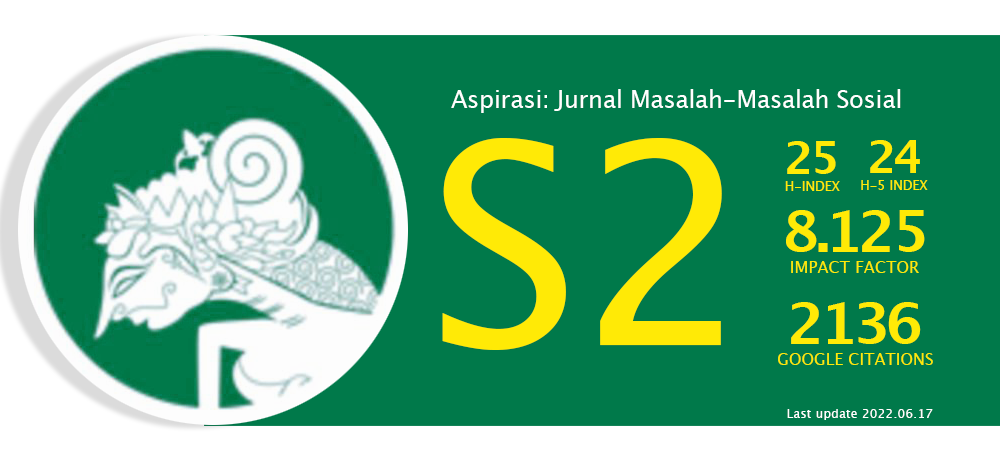Korelasi antara Persepsi Kualitas Layanan dengan Persepsi Korupsi Skala Kecil di Balai Diklat Keagamaan Semarang
Abstract
The relationship between the level of public service quality and the level of corruption perception qualitatively requires quantitative testing. This research is correlative descriptive research using a combination method approach. Sampling techniques use purposive sampling methods. Quantitative data analysis used is a descriptive statistical analysis using Pearson's Product Moment. The service quality perception scale applied, which is closer to 4, means the better, while the corruption perception scale that is applied closer to 1 means the better. The results obtained from this study show that the level of perception of the quality of public services and the perception of corruption have a correlation coefficient value of -0.506 (moderate/strong enough). The variable dimension of service quality that has the strongest correlation with the majority of variable dimensions of corruption perception is the assurance dimension as measured from indicators of expertise and integrity of officers. Support and supervision from the government and the House of Representatives in Commission VIII are needed to improve the quality of service in the Ministry of Religious Affairs. The improvement of public services can be done in a comprehensive and integrated way.
Abstrak
Hubungan tingkat kualitas layanan publik dengan tingkat persepsi korupsi berdasarkan riset kualitatif memerlukan pengujian kuantitatif. Penelitian ini bertujuan untuk menganalisis hubungan antara persepsi kualitas layanan dengan persepsi korupsi di suatu layanan publik serta menganalisis hubungan dimensi kedua variabel tersebut. Penelitian ini merupakan riset deskriptif korelatif menggunakan pendekatan metode kombinasi. Teknik pengambilan sampel menggunakan purposive sampling. Analisis data kuantitatif menerapkan analisis statistik deskriptif Pearson’s Product Moment. Skala persepsi kualitas layanan yang diterapkan yaitu makin mendekati 4 bermakna makin baik, sedangkan skala persepsi korupsi yang diterapkan makin mendekati 1 bermakna makin baik. Hasil penelitian ini adalah tingkat persepsi kualitas layanan publik dan persepsi korupsi memiliki nilai koefisien korelasi sebesar -0,506 (kategori sedang/cukup kuat). Dimensi variabel kualitas layanan yang memiliki korelasi terkuat dengan mayoritas dimensi variabel persepsi korupsi adalah dimensi assurance yang diukur dari indikator keahlian dan integritas petugas. Dukungan dan pengawasan dari pemerintah dan DPR RI di Komisi VIII sangat dibutuhkan untuk meningkatkan kualitas layanan pada satuan kerja di lingkungan Kementerian Agama. Peningkatan pelayanan publik tersebut bisa dilakukan dengan cara komprehensif dan terpadu.
Keywords
Full Text:
PDFReferences
Ardisasmita, M. S. (2006). Definisi korupsi menurut perspektif hukum dan e-announcement untuk tata kelola pemerintahan yang lebih terbuka, transparan, dan akuntabel. Seminar Nasional Upaya Perbaikan Sistem Penyelenggaraan Pengadaan Barang/Jasa Pemerintah, 1–20. Diakses dari https:// www.kppu.go.id/docs/Artikel/Seminar PBJ.pdf
Argandoña, A. (2005). Corruption and companies: the use of facilitating payments. Journal of Business Ethics, 60(3), 251–264. https://doi.org/10.1007/ s10551-005-0133-4
Badan Pusat Statistik. (2017, Juni 15 ). Indeks perilaku anti korupsi (IPAK). Berita Resmi Statistik No. 58/06/Th. XX, 15 Juni 2017.
Baez-Camargo, C., Bukuluki, P., Sambaiga, R., Gatwa, T., Kassa, S., & Stahl, C. (2020). Petty corruption in the public sector: A comparative study of three East African countries through a behavioural lens. African Studies, 79(2), 232–249. https:// doi.org/10.1080/00020184.2020.1803729
Bauhr, M., & Charron, N. (2017). Insider or outsider? Grand corruption and electoral accountability. Comparative Political Studies, 51(4), 415–446. https://doi. org/10.1177/0010414017710258
Bauhr, M., Charron, N., & Wängnerud, L. (2018). Exclusion or interests? Why females in elected office reduce petty and grand corruption. European Journal of Political Research, 58(4), 1–23. https://doi. org/10.1111/1475-6765.12300
Berkovich, I. (2016). The corrupted industry and the “wagon-wheel effect”: A cross-country exploration of the effect of government corruption on public service effectiveness. Administration and Society, 48(5), 559–579. https://doi. org/10.1177/0095399715607287
Emmanuel, M., & Qijun, L. (2019). The impact of corruption on government public services quality, justice and cost of businesses regulations in developing world. International Journal of Innovation and Research in Educational Sciences, 6(1), 24–36.
Fachrudin, F. (2016, Agustus 7). Dirjen Bimas Buddha jadi tersangka korupsi, Menag siapkan Plt. Kompas.com. Diakses dari https://nasional.kompas.com/ read/2016/07/08/20483191/dirjen.bimas. agama.buddha.jadi.tersangka.korupsi. kemenag.siapkan.plt?page=all
Fariz, D. (2019). Pemerintahan joko widodo dan serangan politik terhadap KPK. Integritas, 5(2), 19–33. https://doi.org/10.32697/ integritas.v5i2.468
Gupta, A., & Shrestha, G. L. (2020). Citizen charter in nepali public sector organisations: Does it really work? Policy & Governance Review, 5(1), 18–32. https:// doi.org/10.30589/pgr.v5i1.368
Gupta, S., Davoodi, H. R., & Tiongson, E. (2000). Corruption and the provision of health care and education services. IMF Working Papers: Vol. June (WP/00/116; Issue 116). https://doi. org/10.5089/9781451853926.001
Hariyanto. (2012). Priyayisme dan korupsi kolusi nepotisme (KKN): Studi status group di Kabupaten Sleman Provinsi Daerah Istimewa Yogyakarta. Aspirasi: Jurnal Masalah-Masalah Sosial, 3(2), 111–129. Diakses dari http://jurnal.dpr.go.id/index. php/aspirasi/article/view/264
Haryono, H. (2016). Risywah (suap-menyuap) dan perbedaannya dengan hadiah dalam pandangan hukum Islam. Al Mashlahah Jurnal Hukum dan Pranata Sosial Islam, 4(7), 429–449. https://doi.org/10.30868/ am.v4i07.155
Ilhaamie, A. G. A. (2010). Service quality in Malaysian public service: Some findings. International Journal of Trade, Economics and Finance, 1(1), 40–45. https://doi. org/10.7763/ijtef.2010.v1.8
Iqbal, M. M., Firnando, S., Gego, B. E., Ardana, G. I., & Fauzi, A. M. (2020). Pandangan masyarakat atas pembuatan SIM di Surabaya. JPAP: Jurnal Penelitian Administrasi Publik, 6(2), 185–201. https:// doi.org/10.30996/jpap.v6i2.4296
James, S., Murphy, K., & Reinhart, M. (2005). The citizen’s charter: How such initiatives might be more effective. Public Policy and Administration, 20(2), 1–18. https://doi. org/10.1177/095207670502000201
Kadir, A. R. (2014). Umat minoritas dalam pelayanan kementerian agama: Menyasar penganut agama Budha di kota Jayapura provinsi Papua. Jurnal “Al-Qalam”, 20(1), 57–64. https://doi.org/10.31969/alq. v20i1.215
Kapeli, N. S., & Mohamed, N. (2015). Insight of anti-corruption initiatives in Malaysia. Procedia Economics and Finance, 31(15), 525–534. https://doi.org/10.1016/s2212- 5671(15)01197-1
Kemenag. (2021). BDK Semarang menuju wilayah birokrasi bersih dan melayani. Diakses dari https://kemenag.go.id/read/ bdk-semarang-menuju-wilayah-birokrasibersih-dan-melayani-v3vdk, pada 28 Mei 2022.
Kimya, F. (2019). Political economy of corruption in Turkey: Declining petty corruption, rise of cronyism? Turkish Studies, 20(3), 351–376. https://doi.org/10 .1080/14683849.2018.1531352
Kotler, P., & Keller, K. L. (2016). Marketing management (15th ed.). Pearson.
Komisi Pemberantasan Korupsi. (2006). Memahami untuk membasmi: Buku panduan untuk memahami tindak pidana korupsi. Jakarta, Indonesia: Komisi Pemberantasan Korupsi. Diakses dari https://www.kpk.go.id/gratifikasi/BP/ buku_saku_ korupsi.pdf
Komisi Pemberantasan Korupsi. (2011). Rencana strategis komisi pemberantasan korupsi 2011-2015. Komisi Pemberantasan Korupsi. https://cms.kpk.go.id/storage/ 433/ Renstra_KPK_2012-2015.pdf
Komisi Pemberantasan Korupsi. (2020). Rencana strategis komisi pemberantasan korupsi 2020-2024. Komisi Pemberantasan Korupsi. https://www.kpk.go.id/id/tentang -kpk/rencana-strategis-kpk
Laksmita, A. H. M., & Wahyudi, A. (2017). Rasionalitas pengguna jasa calo dalam pengurusan SIM baru di Polres Sidoarjo. Paradigma, 5(1), 1–7.
Lokadata. (n.d.).Indeks persepsi korupsi Indonesia, 2004–2020. Diakses dari https://lokadata.beritagar.id/chart/ preview/indeks-persepsi-korupsiindonesia-2004-2020-1611921280, pada 12 April 2022.
Mashali, B. (2012). Analyzing the relationship between perceived grand corruption and petty corruption in developing countries: Case study of Iran. International Review of Administrative Sciences, 78(4), 775–787. https://doi. org/10.1177/0020852312455991
Monteduro, F., Hinna, A., & Moi, S. (2016). Governance and corruption in the public sector: An extended literature review. Studies in Public and NonProfit Governance, 5, 31–51. https://doi. org/10.1108/S2051-663020160000005002
Nguyen, T. V., Bach, T. N., Le, T. Q., & Le, C. Q. (2017). Local governance, corruption, and public service quality: Evidence from a national survey in Vietnam. International Journal of Public Sector Management, 30(2), 137–153. https://doi.org/10.1108/ IJPSM-08-2016-0128
Parasuraman, A., Zeithaml, V. A., & Berry, L. (1985). A conceptual model of service quality and its implications for future research. The Journal of Marketing, 49(4), 41–50. https://doi.org/10.2307/1251430
Paruntu, D. D. (2014). Tolok ukur penegakkan hukum terhadap tindak pidana gratifikasi. Lex Crimen, 3(2), 42–53. Diakses dari https://ejournal.unsrat.ac.id/index.php/ lexcrimen/article/view/4544/4072
Praja, S. A. (2017). Pelaksanaan standar pelayanan pajak kendaraan bermotor di kantor bersama Samsat UPT Kutai Kartanegara. Jurnal Administrative Reform, 5(2), 103–111. https://doi.org/10.52239/jar. v5i2.842
Purwanto, E. A., Tyastianti, D., Taufiq, A., & Novianto, W. (2016). Pelayanan publik: Modul pelatihan dasar calon PNS. Lembaga Administrasi Negara Republik Indonesia.
Pusparisa, Y. (2019, Maret 23). Bentangan kasus korupsi Kementerian Agama. Diakses dari https://katadata.co.id/ ariayudhistira/infografik/5e9a551407483/ bentangan-kasus-korupsi-kementerianagama, pada 28 Mei 2022.
Rachmawati, T., & Nasution, S. J. (2015). Nilai demokrasi dalam pelayanan publik: Studi kasus Kantor Imigrasi Bandung. JKAP (Jurnal Kebijakan dan Administrasi Publik), 19(2), 133–143. https://doi.org/10.22146/ jkap.8166
Riduwan, R., & Kuncoro, E. A. (2014). Cara menggunakan dan memaknai path analysis (analisis jalur) (Edisi keenam). Alfabeta.
Riwukore, J. R., Manafe, H., Habaora, F., Susanto, Y., & Yustini, T. (2020). Strategi pencegahan dan pemberantasan korupsi di pemerintah kota Kupang, provinsi Nusa Tenggara Timur, Indonesia. Aspirasi: Jurnal Masalah-Masalah Sosial, 11(2), 229– 242. https://doi.org/10.46807/aspirasi. v11i2.1556
Sari, E., Mulyadi, M., Yatimah, D., Maulana, R., Solihin, S. (2021). Model manajemen pendidikan antikorupsi berbasis kepemimpinan kenabian. Aspirasi: Jurnal Masalah-Masalah Sosial, 12(2), 217- 236. https://doi.org/10.46807/aspirasi. v12i2.2495
Setyaningrum, D., Wardhani, R., & Syakhroza, A. (2017). Good public governance, corruption and public service quality: Indonesia evidence. International Journal of Applied Business and Economic Research, 15(19), 327–338.
Sitorus, R. C. B. (2014). Komunikasi informatif sebagai upaya meminimalisir keberadaan calo dalam pembuatan surat ijin usaha perdagangan (SIUP). Publika: Jurnal Ilmu Administrasi Negara, 3(4), 1–13. https:// doi.org/10.26418%2Fpublika.v3i4.445
Steidlmeier, P. (1999). Gift giving, bribery and corruption: Ethical management of business relationships in China. Journal of Business Ethics, 20(2), 121–132. https:// doi.org/10.1023/A:1005960026519
Sugiyono. (2017). Metode penelitian kombinasi (mixed methods) (Cet. 9). Alfabeta.
Susilo, W. D., Angraeni, S., & Partohap, T. H. (2019). Survei penilaian integritas: Alternatif pengukuran kinerja pemberantasan korupsi. Jurnal Antikorupsi Integritas, 05(2), 165–189. https://doi.org/10.32697/ INTEGRITAS.V5I2.478
Syaifullah, D. H. (2019). Kepuasan masyarakat terhadap layanan keagamaan oleh direktorat jenderal bimbingan masyarakat Buddha. Jurnal SMaRT Studi Masyarakat, Religi dan Tradisi, 05(01), 73–84. https:// doi.org/10.18784/smart.v5i1.761
Syaifullah, D. H. (2020). Korupsi kecil pada layanan keagamaan direktorat jenderal bimbingan masyarakat Buddha. Jurnal SMaRT Studi Masyarakat, Religi Dan Tradisi, 06(02), 293–305. https://doi. org/10.18784/smart.v6i2.1070
Sylwester, K. (2019). Extortion or costreduction: Why do firms pay bribes? Journal of Applied Economics, 22(1), 85– 101. https://doi.org/10.1080/15140326. 2018.1526876
Tim Spora, K. (2015)Tim Spora, K. (2015). Kapita selekta dan beban biaya sosial korupsi (Cetakan 1). Komisi Pemberantasan Korupsi. https://aclc.kpk. go.id/materi/bahaya-dan-dampak-korupsi/ buku/kapita-selekta-dan-beban-biayasosial
Tradingeconomics. (n.d.). Indonesia - Indeks Korupsi. Diakses dari https://id.tradingeconomics.com/indonesia/ corruption-index, pada 27 Mei 2022.
Transparancey International Indonesia. (2008). Measuring corruption in Indonesia: Indonesia corruption perception index 2008 and bribery index. Transparency International Indonesia.
Wicaksono, F. (2021). Harmonisasi hukum pengaturan sistem gratifikasi pada undang-undang tindak pidana korupsi dengan undang-undang cipta kerja berdasarkan kaidah omnibus law. Jurnal Hukum Magnum Opus, 4(1), 103–113. https://doi.org/10.30996/jhmo.v4i1.4675
Živković, N., Glogovac, M., & Kovačević, B. (2020). Determining the quality of municipal services using servqual model. 5th IPMA SENET Project Management Conference 2019, Atlantic Press, 108(Senet), 16–21. https://doi.org/10.2991/senet-19.2019.4
DOI: https://doi.org/10.46807/aspirasi.v13i1.2989
Refbacks
- There are currently no refbacks.







